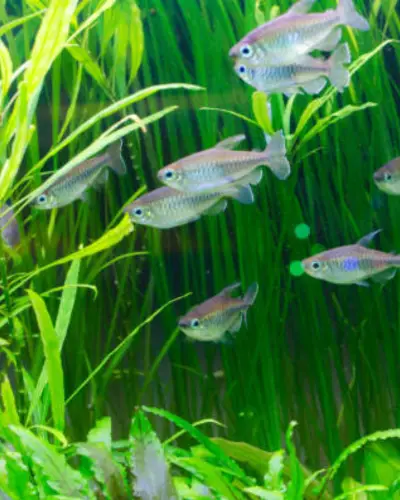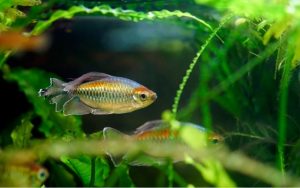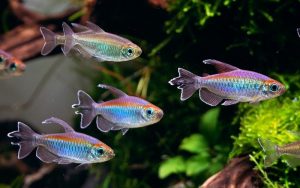How many Congo tetras should be kept together in a tank? Congo Tetras are beautiful and vibrant freshwater fish popular with hobbyists looking to add color and life to their aquariums.
These active and peaceful fish are known for their striking red, blue, and black coloration and playful and social behavior.
One common question among aquarists is how many Congo tetras should I keep in aquarium to ensure the fish’s well-being and happiness.

In this article, we will explore the ideal number of Congo Tetras that should be kept together in a community tank and discuss the importance of proper tank size, water parameters, and social dynamics when it comes to housing these beautiful fish.
Whether you are a beginner or an experienced aquarist, understanding the ideal number of Congo Tetras to keep together will help create a thriving and harmonious aquarium environment. Let’s dive in and learn more about these fascinating fish and how to care for them properly.
Table of Contents
ToggleHow Many Congo Tetras Should Be Kept Together?
Congo tetras are a schooling fish found in the Congo River basin. If you want to keep them, it’s best to keep them in a group of at least 6-8 individuals in a larger tank. Since they can grow up to 3 inches in length, a heavily planted tank with java moss and a soft substrate is ideal.

Male Congo tetras can be territorial and aggressive toward each other, so it’s essential to monitor their behavior. They may nip the fins of different fish, like guppies or neons.
It is also recommended that Congo tetras be kept with peaceful tank mates like cory catfish or small cichlids. Congo tetras can be quite sensitive to changes in water quality, so regular water changes and stable water parameters are crucial for their well-being.
Understanding Congo Tetra Aquarium & Tankmates
Congo tetras are beautiful and active fish that can add a lot of excitement to your aquarium. If you’re considering keeping Congo tetras in a tank, it’s essential to consider the tankmates that will be compatible with them.
Congos do well with other peaceful tropical fish like Danios, emperor tetras, and neon tetras. They are best kept in a large tank with plenty of swimming space, so a 30 gallon or larger tank is recommended. If you’ve already set up a smaller tank, it may be best to consider other options for tankmates.
When it comes to breeding Congos, they are egg scatterers who deposit their spawn on the bottom of the tank. To encourage breeding, provide a breeding tank with plenty of mop or peat moss for the Congo’s Congos to deposit their eggs on.
Infusoria can be used to feed the fry once they hatch. It’s important to maintain good water quality and proper filtration in the breeding tank to ensure the success of the breeding process.
Congo Tetra Diet and Feeding
The Congo Tetra is an omnivore fish species native to the Congo River basin in Africa. In the wild, they feed on a variety of foods, including insects, worms, crustaceans, plant matter, and algae.
They are not picky eaters and will readily accept a variety of foods in the aquarium. Here’s a guide on what to feed your Congo Tetra and how often:
Diet:
- High-quality flake food or mini pellet: This should be the staple of your Congo Tetra’s diet. Choose a flake food or mini pellet formulated explicitly for omnivorous fish.
- Frozen or live bloodworms, brine shrimp, or daphnia: These foods are a good protein source and will help keep your Congo Tetras healthy and active. You can feed them frozen or live bloodworms, baby brine shrimp, or daphnia a few times a week.
- Spirulina flakes or tablets: These foods are a good source of vegetable matter and will help to keep your Congo Tetras‘ colors bright. You can feed them spirulina flakes or tablets a few times a week.
Feeding:
- Feed your Congo Tetras two to three small meals per day.
- Avoid overfeeding, as this can lead to water quality problems.
- If you notice that your Congo Tetras are not eating, try offering them a different type of food.
- You can also try soaking their food in garlic juice before feeding it to them. This can help to stimulate their appetite.
Breeding Congo Tetras
Trying to breed Congo tetras can be a rewarding experience for aquarium fish keepers. It’s crucial to provide the pair of congo with a suitable biotope aquarium that replicates their natural region of the Congo.
These bottom dwellers thrive in acidic water and need plenty of swimming space. A sized school of at least six or seven Congos is ideal for breeding. The fish also need enough food to stay healthy and avoid fungus infections.
With the right conditions, a pair of Congo tetras will usually spawn in a tank with moss or spawning mops. These fish can reach up to 1 inch in size as adults, and they are known for their long fins and active swimming behavior.
Cory cats or cories make good tankmates for Congo tetras because they are peaceful bottom dwellers that won’t overshadow them. However, it’s important to avoid keeping aggressive fish like kribs or pelvicachromis with the tetras, as they may be stressed by their presence.
In addition, fish with flowing fins, like loachs, may also cause problems for the tetras. To provide a better experience for the fish, it’s essential to ensure that the tank is correctly set up and that all inhabitants have enough space to thrive.
Commonly Asked Questions about How Many Congo Tetras Should Be Kept Together (FAQs)
How many Congo tetras are in a 55-gallon tank?
How many Congo tetras are in a 55-gallon tank? The number of Congo tetras in a 55-gallon tank depends on other fish, but a good rule of thumb is 8-12. They are schooling fish and need a group for comfort.
Are Congo tetras aggressive?
Congo tetras are generally peaceful fish but can be nippy towards smaller tankmates. They do best in a school of at least 6 with similarly sized community fish.
What fish go with a Congo tetra?
Congo tetras are peaceful with similar-sized fish. Good tankmates include neon tetras, cardinal tetras, Corydoras catfish, and Rasboras. Avoid tiny fish the Congos might nip at.
How many Congo tetras are in a 75-gallon tank?
How many tetras can you have in a 75-gallon tank? The number of Congo tetras for a 75-gallon tank depends on other fish. Aim for 1 gallon per inch of adult fish. Congo tetras reach 4 inches so that a 75-gallon tank could hold around 18 Congo tetras.
How big do Congo tetra fish get?
Congo tetras are medium-sized fish, with males reaching up to 3 inches and females slightly smaller at 2.75 inches. These vibrant male and female fish are a beautiful addition to a properly sized-aquarium.
How many Congo tetras should I keep?
A good starting point is 6 Congo tetras for a 10-gallon tank. They are schooling fish and need a group for comfort. But remember, the more fish, the bigger the tank you’ll need.
Conclusion
In conclusion, the Congo Tetra is an enchanting fish that brings vibrancy and elegance to any aquarium. Its shimmering colors, graceful movements, and peaceful nature make it a delightful addition to a community tank. As explored in this blog post, the Congo Tetra thrives when kept in groups, allowing them to display their natural behaviors and create a stunning visual spectacle.
To ensure the happiness and well-being of these magnificent creatures, it is crucial to provide them with ample space and suitable tank mates. A minimum of six Congo Tetras is recommended, although a more extensive group will create a more dynamic and harmonious environment. By maintaining proper water parameters, providing a well-balanced diet, and creating a comfortable habitat, you can make an ideal home for these stunning fish.
So, if you’re considering adding Congo Tetras to your aquarium, remember that they are social creatures who flourish in the company of their kind. The more, the merrier! Now you know the answer to the question, “How many Congo Tetras should be kept together?” Please keep them in a group, and let their beauty and grace mesmerize you and your guests.
Recommended posts
- The Ideal Congo Tetra Temperature: (Complete Beginner Guide)
- Are Congo Tetras Aggressive: (Tips for Peaceful Aquarium)
- The Ideal Congo Tetra Tank Size: (A Comprehensive Guide)
- The Basics of Congo Tetra Breeding: A Step-by-Step Guide
- Cherry Red Congo Tetra 101: A Comprehensive Beginner’s Guide





